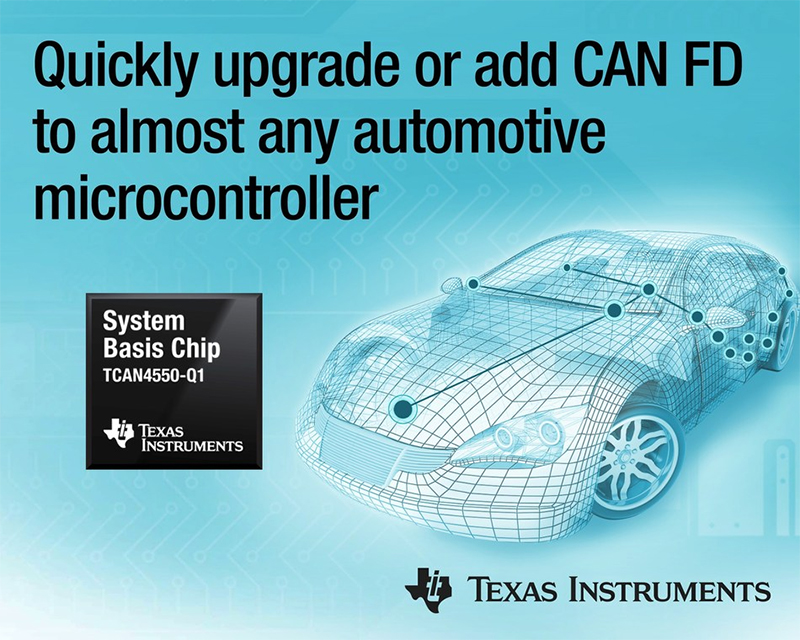 New automotive SBC helps designers add CAN FD without changing their microcontroller, reducing design and time to market for in-vehicle networks
New automotive SBC helps designers add CAN FD without changing their microcontroller, reducing design and time to market for in-vehicle networks
DALLAS and INDIA (June 11, 2019) – Texas Instruments (TI) (NASDAQ: TXN) today introduced an automotive system basis chip that is the industry’s first to integrate a controller and transceiver for Controller Area Network with Flexible Data Rate (CAN FD). Designed to meet the high-bandwidth and data-rate flexibility needs of in-vehicle networks, the TCAN4550-Q1 uses the Serial Peripheral Interface (SPI) bus of almost any microcontroller to implement, with minimal hardware changes, a CAN FD interface or increase the amount of CAN FD bus ports in a system.
Previously, designers had to incorporate multiple discrete components into their designs or change microcontrollers entirely when upgrading to or expanding CAN FD functionality – an often time-consuming and expensive process. With the TCAN4550-Q1 system basis chip (SBC), designers can maintain their existing microcontroller-based architecture and streamline CAN FD upgrade or expansion in body electronics and lighting, advanced driver assistance systems (ADAS) and automotive gateway designs. For product details, see www.ti.com/TCAN4550-Q1-pr.
What is CAN FD?
The CAN FD communications protocol builds on the original CAN bus standard (also known as “Classical CAN”) to help ensure that automotive microcontrollers and connected systems can communicate effectively as the variety and speed of data rates throughout in-vehicle networks continue to evolve. With support for data rates up to 5 Mbps and payloads up to 64 bytes, the CAN FD protocol empowers designers to move data faster in their next-generation automotive applications.
Key features and benefits of TI’s TCAN4550-Q1
- Reduced bill of materials (BOM) and system costs: Designers can simplify their designs with the high integration of the TCAN4550-Q1 – including integrated ±58-VDC bus fault protection, watchdog timer and fail-safe modes – and its cross-compatibility with the Classical CAN protocol.
- Easier bus expansion in automotive designs: Designers can also use the chip to add more CAN FD buses via the existing SPI port in an automotive system when the microcontroller has a limited number of CAN FD ports. Typically this type of bus expansion can require system redesign, which is not necessary when using the TCAN4550-Q1.
- Small power design footprint: With an integrated 125-mA low-dropout (LDO) linear regulator, the TCAN4550-Q1 can power itself while also providing a 70-mA external output that can be used to power sensors or additional components, which enables a smaller power design footprint by reducing the need for external power components.
- Reduced power consumption: The TCAN4550-Q1 helps designers lower system power consumption when in standby mode through wake and inhibit features.
- Increased maximum data rate: The new SBC enables faster programmability of automotive software during vehicle assembly through a maximum data rate of 8 Mbps, which exceeds the 5-Mbps maximum data rate of the CAN FD protocol.
Save space while increasing system performance
This new device joins TI’s growing portfolio of SBCs that integrate CAN FD, CAN, and Local Interconnect Network (LIN) transceivers and power components into single-chip solutions, including the TCAN4550-Q1 and TLIN1441-Q1. These highly integrated devices help designers reduce their BOM, increase system performance and get their designs to market faster, as compared to competing devices with fewer integrated components. Designers can also pair TI SBCs with TI C2000™ microcontrollers to quickly and easily expand the amount of available bus ports while increasing overall system functionality.
Tools and support to speed design
- Easily evaluate the TCAN4550-Q1 and its CAN FD protocol support with the TCAN4550-Q1 evaluation module, available today for $149 from the TI store and authorized distributors.
- Jumpstart designs of size-optimized automotive radar modules with the “Automotive RFCMOS 77GHz radar module reference design with object data output over dual CAN FD.”
Package, availability and pricing
The TCAN4550-Q1 is available now through the TI store and authorized distributors. The TCAN4550-Q1 comes in a 4.5-mm-by-3.5-mm very thin quad flat no-lead package and is priced at US$2.20 in 1,000-unit quantities.
Find out more about TI’s TCAN4550-Q1
- Download the TCAN4550-Q1 data sheet.
- Discover the benefits and features of the TCAN4550-Q1 in this product overview video.
- Learn more about SBCs and CAN FD in these technical articles:
o “System basis chips 101 – A beginner’s guide to CAN, CAN FD and LIN SBCs.”
o “The need for even more speed: CAN FD.”
- Explore the integrated features of the TCAN4550-Q1 in these application notes:
o “Understanding LDO Performance in the TCAN4550-Q1.”
o “TCAN4550 Watchdog Configuration Guide.”
- Search for expert answers in the TI E2E™ Interface forum.
